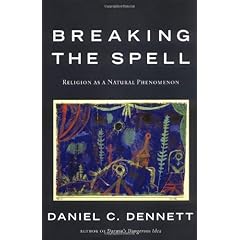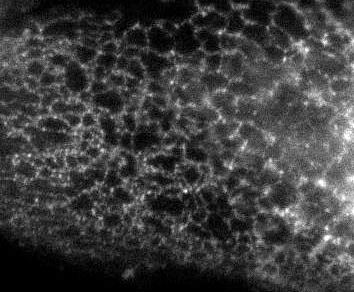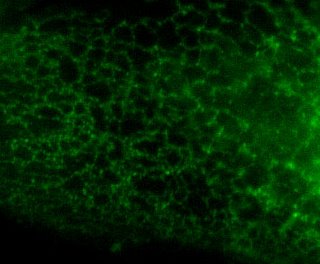Richard Dawkins The Root of all Evil Part I
| yup | |
Daily news and views from a postdoctoral fellow in Cell Biology.



Notice that Brian's paper is a bigger news story than Larry Summers' departure. Ah success!
{Update 2/28/06}
Basic summary: Brian found that Gold, platinum, and some other heavy metals can bind and inactivate MHC II and thus be used to treat autoimmune disorders.
Brian told me that when he discusses his results with many western doctors they are not that interested, while doctors from the developing world are enthralled. Not only is this treatment cheap, but it turns out that many local remedies for arthritis and other autoimmune diseases involve heavy metal administration.
Ref: Stephen L De Wall et al., Noble metals strip peptides from class II MHC proteins. Nature Chemical Biology, Published online: 26 February 2006

It is after all not the case that the role of women in science is the only example of a group that is significantly underrepresented in an important activity and whose underrepresentation contributes to a shortage of role models for others who are considering being in that group. To take a set of diverse examples, the data will, I am confident, reveal that Catholics are substantially underrepresented in investment banking, which is an enormously high-paying profession in our society; that white men are very substantially underrepresented in the National Basketball Association; and that Jews are very substantially underrepresented in farming and in agriculture. These are all phenomena in which one observes underrepresentation, and I think it's important to try to think systematically and clinically about the reasons for underrepresentation.What a bizarre mix of things to say!
And the relatively few women who are in the highest ranking places are disproportionately either unmarried or without children, with the emphasis differing depending on just who you talk to. I agree! A career in the Sciences (or most professions) is not compatible with raising a family. But I think that this is also true for fathers.Larry may have a point in that usually women bare the brunt of the child rearing. However I believe that it's easier for husbands to dump this responsibility on their wives and this maybe facilitated by the type of society we live in.
... and the work that Claudia Goldin and Larry Katz are doing will, I'm sure, over time, contribute greatly to our understanding of these issues and for all I know may prove my conjectures completely wrong.I'll have to look in to these studies ... Now on to IQ ...
I looked at the Xie and Shauman paper-looked at the book, rather-looked at the evidence on the sex ratios in the top 5% of twelfth graders. If you look at those-they're all over the map, depends on which test, whether it's math, or science, and so forth-but 50% women, one woman for every two men, would be a high-end estimate from their estimates. From that, you can back out a difference in the implied standard deviations that works out to be about 20%. And from that, you can work out the difference out several standard deviations. If you do that calculation-and I have no reason to think that it couldn't be refined in a hundred ways-you get five to one, at the high end. Now, it's pointed out by one of the papers at this conference that these tests are not a very good measure and are not highly predictive with respect to people's ability to do that. And that's absolutely right. But I don't think that resolves the issue at all. Because if my reading of the data is right-it's something people can argue about-that there are some systematic differences in variability in different populations, then whatever the set of attributes are that are precisely defined to correlate with being an aeronautical engineer at MIT or being a chemist at Berkeley, those are probably different in their standard deviations as well.Well it's hard to say whether these 5th graders are already "socialized". Also why are there more women (than men) enrolling in college. Does US society affect this? In Canada medical school is dominated by WOMEN!
So my best guess, to provoke you, of what's behind all of this is that the largest phenomenon, by far, is the general clash between people's legitimate family desires and employers' current desire for high power and high intensity, that in the special case of science and engineering, there are issues of intrinsic aptitude, and particularly of the variability of aptitude, and that those considerations are reinforced by what are in fact lesser factors involving socialization and continuing discrimination.Well that's still up for debate. My own opinion is that the clash between family and career, and socialization (the two of which ARE related) are probably the main cause. The lack of support from institutions (such as Harvard which due to its prestige can get away with throwing scraps to it's professors) is also a big problem. Here at the Medical campus the "new research building" was recently completed. I was told that when asked what facilities should be included, most faculty and staff replied "daycare facilities". What did they build? A gym!
I would like nothing better than to be proved wrong, because I would like nothing better than for these problems to be addressable simply by everybody understanding what they are, and working very hard to address them.Cute Larry... Well if anything this episode will be good in the longterm. These are issues that need to be discussed.
From: Lawrence Summers [official@harvard.edu]I guess that's the end of the Summers Saga.
Sent: Tue 2/21/2006 1:05 PM
Subject: Message from President Summers
Attachments:
Dear Members of the Harvard Community,
I write to let you know that, after considerable reflection, I have
notified the Harvard Corporation that I will resign as President of the
University as of June 30, 2006. I will always be grateful for the
opportunity to have served Harvard in this role, and I will treasure the
continuing friendship and support of so many exceptional colleagues and students
at Harvard.
Below are links to my letter to the community, as well as a letter from the
members of the Corporation and a related news release.
Sincerely,
Larry Summers
http://www.news.harvard.edu/gazette/daily/2006/02/21-summers.html
http://www.president.harvard.edu/speeches/2006/0221_summers.html
http://www.news.harvard.edu/gazette/daily/2006/02/21-board.pdf

In his own opinion, Dennett is a hero.
...
Dennett is the sort of rationalist who gives reason a bad name; and in a new era of American obscurantism, this is not helpful.
Dennett flatters himself that he is Hume's heir.
...
In the end, his repudiation of religion is a repudiation of philosophy, which is also an affair of belief in belief. What this shallow and self-congratulatory book establishes most conclusively is that there are many spells that need to be broken.
 So it came as no surprise when a good friend of mine sent me a link to A Slice of Life Scarves. This company uses motifs from the life sciences as patterns for their scarves and ties. Besides Golgi scarves (left) and centriole ties, they even have sarcomere ties (for those power meetings!)
So it came as no surprise when a good friend of mine sent me a link to A Slice of Life Scarves. This company uses motifs from the life sciences as patterns for their scarves and ties. Besides Golgi scarves (left) and centriole ties, they even have sarcomere ties (for those power meetings!)
 {Update 2/18/06}
{Update 2/18/06}

Here are a black & white images with a color overlay (from Gia's paper), that demonstrate the unique distribution that reticulons adopt. Notice how a general ER marker (Sec61-beta) is in the tubular portion and in the nuclear envelope, but that reticulon4a (also called NogoA) is only found in the tubular ER. Note how the black and white image of Rtn4a (but not the color overlay!) clearly demonstrates how reticulons are excluded from the nuclear envelope.

So let me illustrate (literally!) what I mean:
Here is the same image (of a protein localized to the endoplasmic reticulum) in black white, and the 3 colors commonly used:








Looks like she's mouth pipetting, or drinking (we're not sure) some yummy tissue culture media. I hope that this newspaper clipping won't spark riots.